I’m Nazia, and I’m excited to invite you into my kitchen today for a heartwarming rendezvous with one of my all-time favorite recipes – Soybean Paste Stew. Here at Food and Meal, we believe in the power of food to create not just a meal but an experience, a moment that lingers in your memory.
As I found myself caught in the rhythm of our bustling lives, there was a yearning within me for a dish that could encapsulate more than just sustenance. The circumstances were simple – a need to unwind, a desire to reconnect with my roots, and a craving for a bowl that could wrap me in comfort. Enter Soybean Paste Stew, a recipe that resonated with my soul.
Life often throws curveballs, and my journey with this stew was my way of finding equilibrium amidst the chaos. The reasons behind choosing this dish were more emotional than culinary; it was about creating a haven, a safe space within my own home. The earthy aroma of soybean paste, the vibrant medley of vegetables, and the ritual of preparing this stew became my therapeutic escape.
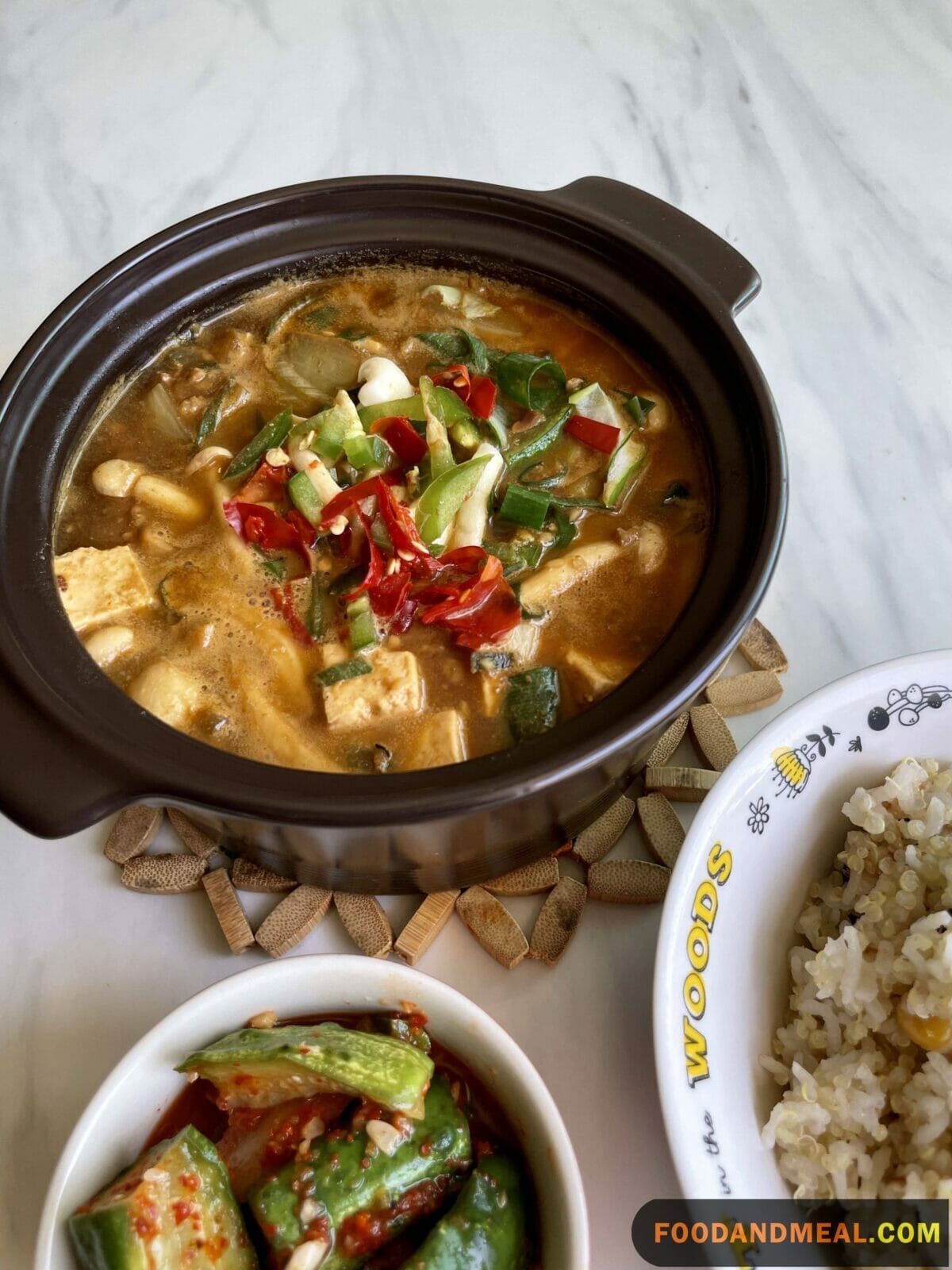
Soybean Paste Stew Recipe
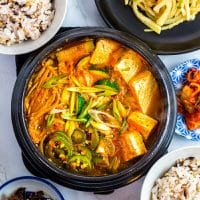
SOYBEAN PASTE STEW
Equipment
Ingredients
- 6 ounces beef or shrimp, peeled and deveined, sliced
- 1 teaspoon vegetable oil
- 3 cups Anchovy Stock (here), Beef Stock (here), or packaged low-sodium stock
- 1/2 onion, chopped
- 1 teaspoon finely chopped garlic
- 1/2 zucchini, cut in half lengthwise and sliced
- 1 small potato, cut into large dice
- 1 Korean green chile, seeded and thinly sliced
- 3 tablespoons doenjang
- 2 teaspoons gochujang
- 1 teaspoon gochugaru
- 1(12- to 14-ounce) block firm tofu, cut into large dice
- 1 scallion, chopped
Instructions
- If using beef, add the vegetable oil to a nonstick stockpot over high heat, and sauté the beef until slightly browned. If using shrimp, skip this step and just add the shrimp with the vegetables.
- Add the anchovy stock, onion, garlic, zucchini, potato, and chile, stir to combine, and bring to a boil.
- Reduce the heat to medium and add the doenjang, gochujang, gochugaru, and tofu. Stir gently to combine. When the stew begins to boil again, turn off heat.
- Serve hot, sprinkled with the scallions.
Video
Notes
SUBSTITUTION TIP: To make a vegetarian version of this stew, use vegetable broth and omit any meat or seafood.
Nutrition
© Food And Meal
This website provides approximate nutrition information for convenience and as a courtesy only. Nutrition data is gathered primarily from the Spoonacular Database, whenever available, or otherwise other online calculators.
Cooking Tips
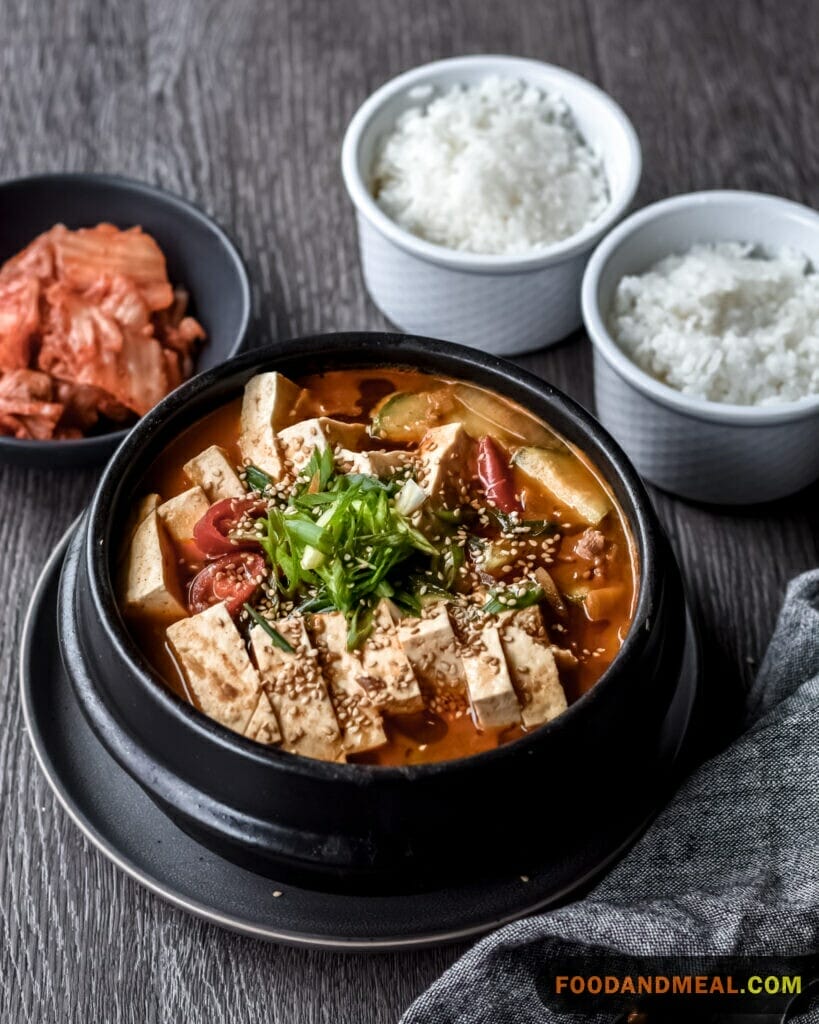
For a dish that transcends mere sustenance, the choice of quality soybean paste is paramount – a rich, traditionally brewed foundation that infuses the stew with authentic depth. Crafting the perfect balance of vegetables, from hearty root vegetables to vibrant greens, transforms the stew into a symphony of flavors. Mindful simmering becomes a therapeutic act, allowing the ingredients to meld into a harmonious blend. Tofu, delicately added towards the end, contributes a layer of creamy texture. The gradual adjustment of seasoning ensures a personalized touch, while the final addition of fresh soybean sprouts imparts a delightful crunch. As the aromas fill the kitchen, the cooking process becomes a sensory journey, a prelude to the shared joy of a communal meal.
Serving Suggestions: Elevate Your Soybean Paste Stew Experience
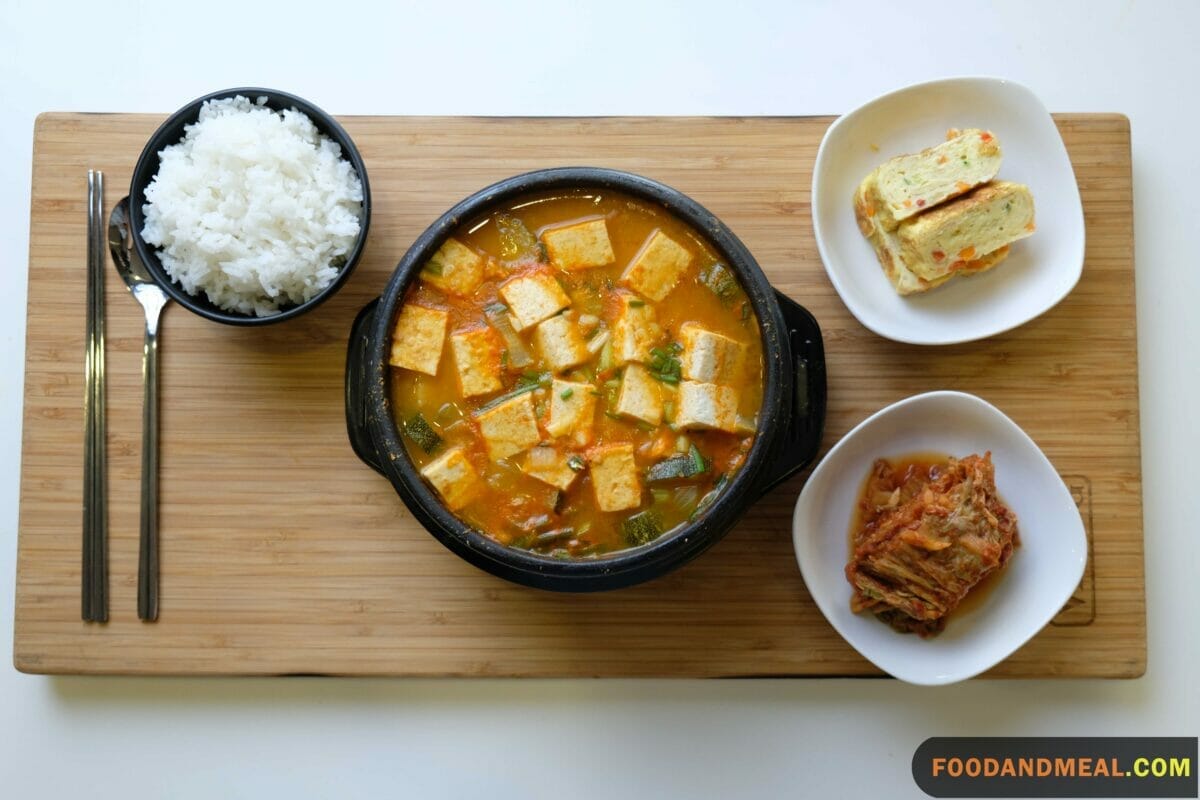
Dive into the rich and comforting depths of the stew by pairing it with the crispy delights of gyoza or the unique texture of natto, creating a harmonious dance of flavors on your palate. For those seeking an extra kick, introduce a dollop of wasabi, offering a spicy twist that perfectly complements the stew’s savory richness. The fusion possibilities are endless – from the crispy crunch of karaage to the delicate freshness of sashimi or the savory goodness of yakisoba noodles, each suggestion adds a layer of complexity and delight to your meal.
To indulge in a comforting combination, consider sipping on a glass of soy milk, imparting a creamy counterpart to the robust stew. For an authentic Japanese culinary experience, pair your Soybean Paste Stew with a bowl of miso soup, doubling down on the umami for a symphony of flavors. Drizzle negi oil over your stew for a burst of aromatic green onion essence, enhancing the overall taste profile. Or, for a heartwarming and classic twist, savor the robust stew alongside the comforting Japanese dish oyakodon, creating a delightful interplay of textures and tastes.
Incorporate these diverse and thoughtfully curated serving suggestions to turn your Soybean Paste Stew into a culinary adventure, ensuring a feast that not only satisfies your appetite but also ignites a symphony of flavors and textures.
Frequently Asked Questions of Soybean Paste Stew
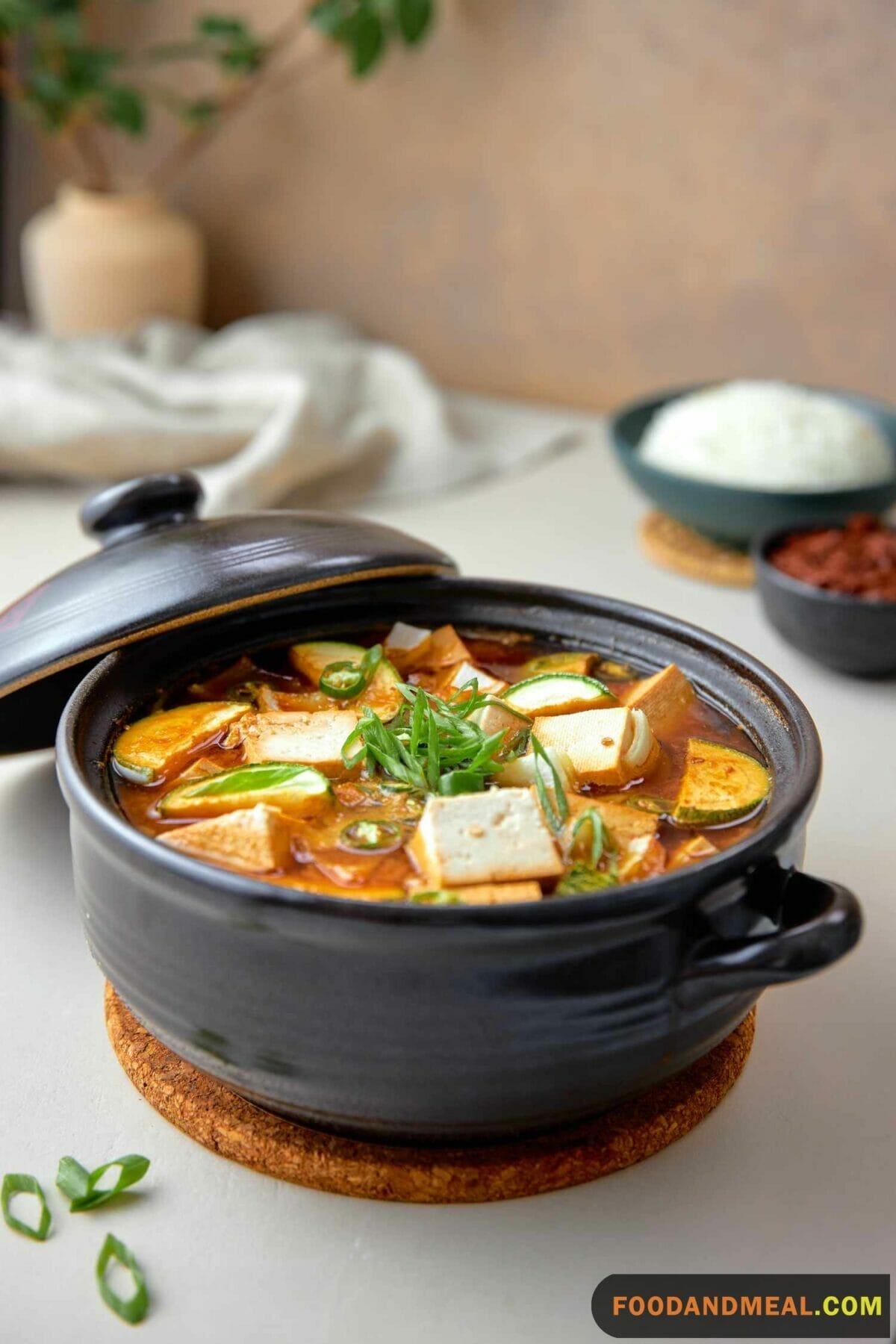
- Is soybean paste stew good for you? Yes, soybean paste stew is a nutritious dish. It contains fermented soybean paste, which is rich in protein, vitamins, and minerals. The inclusion of vegetables and other ingredients adds to its nutritional value, making it a wholesome choice.
- What can I use soybean paste for? Soybean paste is a versatile ingredient. Apart from making stew, it can be used as a base for soups, marinades, or sauces. It adds depth and umami to various dishes, making it a staple in Korean cuisine.
- What does soybean stew taste like? Soybean paste stew, also known as “Doenjang Jjigae,” has a rich and savory umami flavor. The fermented soybean paste contributes a deep, hearty taste, complemented by the combination of vegetables, tofu, and, if included, seafood or meat. The overall taste is comforting and satisfying.
- How many calories are in soybean paste stew? The calorie content of soybean paste stew can vary based on specific ingredients and serving sizes. On average, a serving may contain around 200 to 300 calories. However, it’s essential to consider individual variations in recipes and portions.
- What is Soybean Paste Stew, and what makes it unique? Soybean Paste Stew, known as “Doenjang Jjigae,” is a traditional Korean dish made with fermented soybean paste. Its uniqueness lies in its rich umami flavor, hearty ingredients, and its role as a comforting staple in Korean cuisine.
- Can I customize the ingredients in Soybean Paste Stew? Absolutely! While traditional ingredients include tofu, vegetables, and sometimes seafood or meat, feel free to customize the stew according to your preferences. Experiment with mushrooms, different vegetables, or even seafood to make it your own.
- Is Soybean Paste Stew spicy? The level of spiciness can be adjusted to your liking. While Soybean Paste Stew itself isn’t inherently spicy, you can add red pepper flakes or gochugaru (Korean red pepper flakes) to achieve your desired level of heat.
- How do I store leftovers? To store leftover stew, transfer it to an airtight container and refrigerate it. It’s best to consume within 2-3 days to ensure optimal flavors and textures. When reheating, gently warm the stew over low heat to prevent overcooking.
Conclusion
As I bring this blog post to a close, it is my hope that you will find as much joy cooking this Soybean Paste Stew as I have over the years. This hearty, umami-packed stew is a wonderful way to nourish yourself on chilly days or anytime you need comfort.
The savory soybean paste packs a nutritional punch, while the tender meat and vegetables come together in a soul-warming broth. For me, this stew evokes fond memories of my childhood, coming home from school to the welcoming aroma filling our small apartment.
I’m so grateful to be able to share this recipe with the Food and Meal community. Our team is passionate about using wholesome ingredients to create tasty, comforting meals to enjoy with loved ones. We believe food has the power to not only feed our bodies, but also connect us more deeply to each other.
I’d love to hear if you and your family enjoy this stew! Feel free to leave a comment below describing your experience cooking this recipe. Did your kids happily slurp up the rich broth? What songs were you listening to while prepping in the kitchen? I can’t wait to hear how this Soybean Paste Stew makes its way into your home.
Hi! I'm Nazia of ‘Nazia Cooks’, a self-taught baker and cook residing in Chennai. Rooted in the rich South Indian culinary landscape, my palate has expanded to embrace global flavors. I revel in crafting fusion dishes, melding traditions to birth unique tastes.

